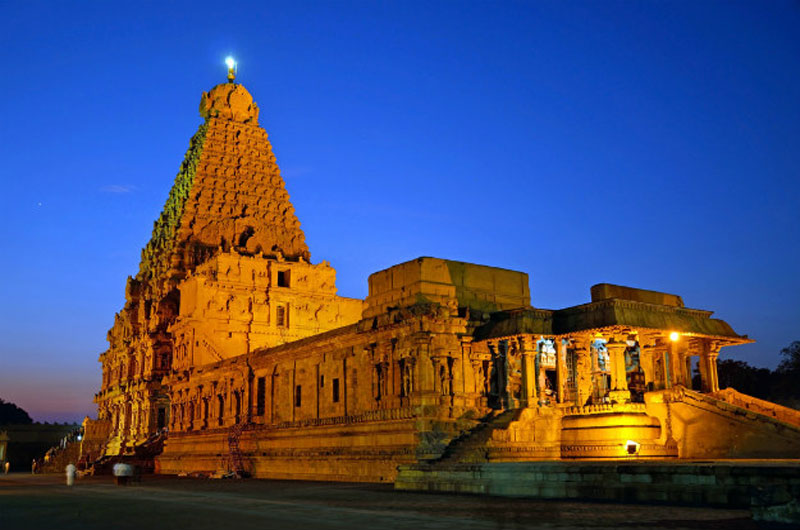
Great Living Chola Temples: Architectural Marvels of Southern India – A World Heritage Site
The Great Living Chola Temples, located in Tamil Nadu, India, comprise three magnificent temples that exemplify the architectural achievements of the Chola dynasty. These temples—Brihadeeswarar Temple at Thanjavur, Brihadeeswarar Temple at Gangaikonda Cholapuram, and Airavatesvara Temple at Darasuram—are UNESCO World Heritage Sites celebrated for their grandeur, scale, and artistic brilliance. Built between the 10th and 12th centuries CE, they showcase the zenith of Dravidian temple architecture and stand as enduring symbols of Chola cultural and religious patronage.
Historical Background
- Chola Dynasty
- Flourished as a powerful empire in South India from the 9th to the 13th centuries CE.
- Known for their maritime trade, cultural advancements, and patronage of the arts.
- Temple Construction
- Built during the reigns of Chola kings Rajaraja I, Rajendra I, and Rajaraja II.
- Each temple reflects unique architectural styles and religious significance.
Architectural Marvel
- Design and Structure
- Dravidian style characterized by towering gopurams (gateway towers), vimanas (main sanctum towers), mandapas (pillared halls), and intricate sculptures.
- Built using granite and sandstone, showcasing exceptional craftsmanship and engineering skills.
- Notable for their massive scale and precise alignments based on astronomical principles.
- Notable Temples
- Brihadeeswarar Temple, Thanjavur: Features a 66-meter tall vimana with a monolithic cupola, adorned with exquisite sculptures and frescoes.
- Brihadeeswarar Temple, Gangaikonda Cholapuram: Known for its similar architectural style to Thanjavur, constructed to commemorate Rajendra I’s victorious campaign.
- Airavatesvara Temple, Darasuram: Renowned for its intricate carvings, including depictions of celestial beings, musicians, and dancers.
Specialty of Great Living Chola Temples
- Architectural Legacy
- Represents the pinnacle of Dravidian temple architecture during the Chola period.
- Showcases the integration of art, sculpture, and religious symbolism.
- Cultural Significance
- Served as active centers of worship and pilgrimage for centuries.
- Reflects Chola patronage of Hinduism, Shaivism, and the arts.
Tourism Aspects
- Visitor Experience
- Guided tours available to explore each temple complex and learn about their historical and architectural significance.
- Audiovisual presentations and exhibitions on Chola history, art, and culture.
- Religious ceremonies and festivals offering insights into local traditions and rituals.
- Nearby Attractions
- Thanjavur Palace: Adjacent to Brihadeeswarar Temple, housing a museum showcasing Chola artifacts and royal memorabilia.
- Swamimalai Temple: A significant Murugan temple near Darasuram, known for its religious importance and architectural beauty.
- Chola Bronzes Gallery: Exhibits at local museums featuring Chola-era bronze sculptures and artifacts.
- Events and Festivals
- Mahashivaratri: Celebrated with fervor at all three temples, attracting devotees and tourists.
- Natyanjali Dance Festival: Held annually at Brihadeeswarar Temple, showcasing classical dance performances in honor of Lord Shiva.
Impact on Locality
- Economic Significance
- Boosts tourism and local economy through visitor spending and hospitality services.
- Supports local artisans and craftsmen involved in restoration and preservation efforts.
- Cultural Influence
- Enhances regional pride and historical awareness.
- Promotes preservation of traditional crafts and cultural heritage.
Preservation and Challenges
- Conservation Efforts
- Managed by the Archaeological Survey of India (ASI) and local authorities.
- Ongoing restoration and maintenance to preserve the architectural integrity and historical authenticity of the temples.
- Challenges
- Preservation against natural weathering, pollution, and visitor impact.
- Balancing tourism with conservation needs to ensure sustainable development and cultural preservation.
Conclusion
The Great Living Chola Temples stand as masterpieces of South Indian architecture and cultural heritage, reflecting the Chola dynasty’s grandeur and artistic finesse. As UNESCO World Heritage Sites, they attract visitors from around the world, offering profound insights into India’s medieval history, religious practices, and architectural achievements. The ongoing efforts to conserve and promote these temples ensure that they continue to inspire awe and admiration for their monumental scale, artistic splendor, and historical significance for generations to come.
